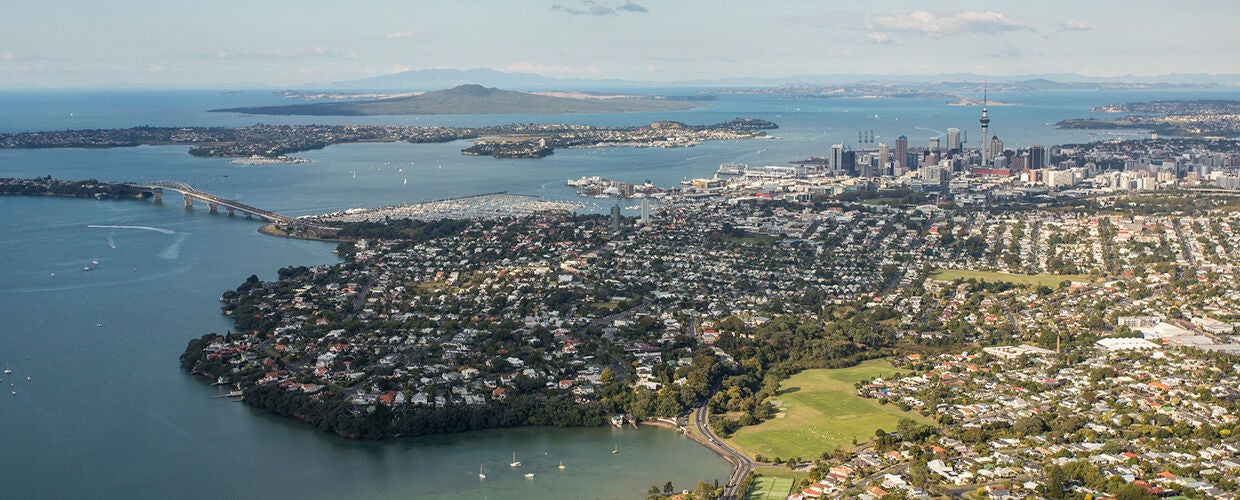Buying into Auckland’s Future

But beyond the perennial boxes-to-tick such as affordability, bedroom count and school zones, it’s increasingly vital to weigh future factors including planned transport links, infrastructure and developments – along with the move towards higher-density housing and the Unitary Plan.
If you buy a home in Tāmaki Makaurau, you’re buying into the city’s future – so it pays to understand what’s coming.
FUTURE CITY
Over the past 20 years, Auckland’s population has doubled to 1.6 million and the housing landscape has changed dramatically.
Quarter-acre sections have been subdivided. Baby Boomers are downsizing. Young people want accommodation close to the city. More families are embracing medium-density living.
Local and central government are racing to keep up. We have the Unitary Plan, The Auckland Plan (looking ahead to 2050), the Mayoral Housing Taskforce and the $28 billion Auckland Transport Alignment Project (ATAP). KiwiBuild promises thousands of new homes; regeneration is happening across the city and big infrastructure projects are underway.
The basic premise is to encourage medium-density living connected by efficient transport, and this is redrawing the map. If you’re buying, it’s worth investigating how all of this could impact your choice of home, suburb and schools.
The Auckland Plan 2050 shows the council’s long- and short-term plans for growing the city. It highlights urban growth hotspots from Wellsford and Warkworth in the north, to Pukekohe in the south.
The breadth and scope of developments are immense. When viewed through the lens of ATAP, the city’s changing housing map becomes clearer.
**SOUTH **
The light-rail project linking the city to Māngere and the airport is about more than moving airline passengers. The route is the target of rapid housing expansion, and will boost development in Mt Roskill, Onehunga and Māngere.
The Government is developing state housing, affordable homes and market homes in Mt Roskill and Māngere. Projects will benefit from easy access to light rail – connecting with heavy rail, buses, cycling and walking.
Housing New Zealand subsidiary HLC has started seven major developments around Māngere to provide 7,000 new market-value and affordable homes, in addition to 3,000 state homes – in an area forecast to grow by half in 30 years, to 300,000 people.
With light rail, and a planned rapid bus transit corridor from the airport to Botany via Manukau, residents will have easy access to public transport north to the city, to the south and east.
Further south, Pukekohe is set for significant growth under the Auckland Plan 2050, with 1,700 hectares earmarked for urban development. Key to growth is electrification of the line between Papakura and Pukekohe. This means passengers will have to board just one train and won’t have to change at Papakura. Add stops at Paerata and Drury, and a $16 million bus and train station in Pukekohe with an 87-vehicle park-and-ride, and Franklin’s green pastures will seem even greener.
EAST
Work has begun on the $1.4 billion Eastern Busway. Within two years, this will provide a dedicated bus route between Panmure, Pakuranga and Botany town centres. By linking with the new train station at Panmure, it will cut the CBD commute from Botany to 40 minutes and have a huge impact on this area.
The Auckland Manukau Eastern Transport Initiative will connect communities and improve access to jobs and recreation. But it’s also about urban design: modernised town centres, green spaces, cycle and walking paths and other improvements along the route.
The project seeks to lift the potential of east Auckland and boost development.
NORTH and WEST
The planned light-rail line towards Kumeu, via Westgate and Lincoln Road, also promises significant development along its route.
Future urban areas have been earmarked around Whenuapai, Westgate and Kumeu, with 14,000 homes and 75,000 more residents planned in coming decades. Light rail promises a 30-minute commute from Westgate to the city.
Meanwhile, the planned Northern Busway extension to Albany, with a station at Rosedale and dedicated bus lanes between Albany and Silverdale, will ease the commute for city workers who make the North Shore their home.
It’s more important than ever for home buyers to study planned infrastructure. And check the Unitary Plan; or you could find the home you assumed was in the middle of a “Residential – Mixed Housing Suburban” zone borders one earmarked for hundreds of apartments.
Buying in Auckland is a tale of two cities: the one you’re buying into today, and the one you’ll live in tomorrow.